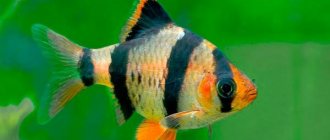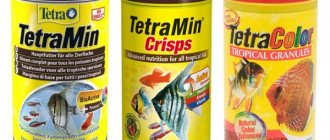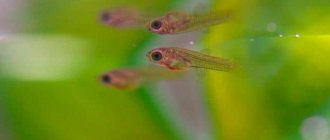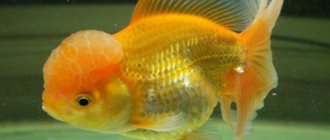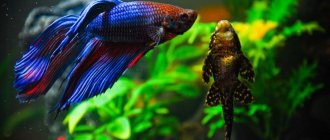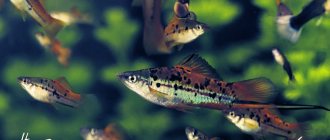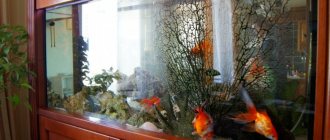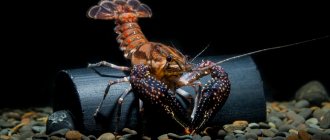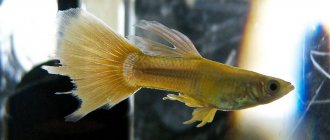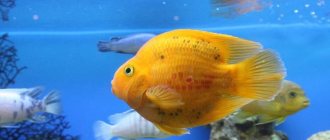When selecting inhabitants for a community aquarium, the owner first of all asks himself: will representatives of different breeds get along in the same area? Will the motley group turn out to be too conflicting, will the larger individuals eat the smaller ones, and will the reservoir turn into a field for constant battles? This is a really important point when designing and populating an artificial aquatic world, and it is important to know the compatibility of aquarium fish so that the hobby does not lead to disappointment.
What factors affect compatibility?
Experienced aquarists will confirm that the livability and compatibility of aquatic inhabitants are associated not only with the degree of their aggression and territoriality. In fact, other equally important factors are taken into account:
- optimal parameters of the aquatic environment - placing lovers of warm and cold water or fresh and salted water in one tank is not recommended;
- layers of habitat - even non-peace-loving creatures can live in the same territory if they do not intersect with other inhabitants, for example, bottom-dwelling catfish get along well with fish that prefer to be near the surface.
If you take into account all the nuances, the aquarium will turn into a comfortable place for fish and other living creatures to live and will delight the owner’s eye.
Basic principles for choosing aquarium fish
When selecting aquarium inhabitants, you must take into account the following information:
- You should not combine large and small fish species, as this combination may result in the destruction of some or all small fish
- predators potentially threatening the more peaceful inhabitants of the aquarium;
- When selecting aquarium inhabitants, you should take into account their temperamental compatibility, since active, mobile specimens may not get along well with slow and calm fish.
Thus, it is necessary to take into account the typical habits of the different fish species, especially their keeping and breeding, as well as the expected final sizes.
Fish of the same species are characterized by distinctive compatibility; they prefer to live in schools in their natural environment. By grouping in schools in this way, they protect themselves from attacks by predators. In an aquarium, it is better to keep them in groups, since such a fish will feel noticeable discomfort when alone. For example, it is known that certain species of bottom and loach fish prefer the company of their own kind.
Angelfish
These original fish from the cichlid genus are very popular among aquarists, as they are beautiful (the name of the breed comes from the words “leaf” and “wing”), extraordinary, and relatively unpretentious. In addition, they get along with inhabitants of other breeds, if they are non-aggressive and have average dimensions. It refers to:
- barbs;
- shellfish;
- zebrafish;
- gourami;
- boots;
- mollies;
- platies;
- plecostomus catfish (pleco);
- rainbows;
- rasboram;
- tetras.
Angelfish coexist peacefully with their fellows if they live in a spacious aquarium. However, it is advisable to place a group of young animals of 4-8 individuals in one tank. Like other cichlids, these fish independently select a mate for themselves - once and for all.
Loaches and shrimp are not the best neighbors for angelfish, but there is still partial compatibility. But the following inhabitants should not be placed in one container with leaf fish:
- cockerels;
- African and South American cichlids;
- goldfish;
- discus;
- guppy;
- brocade carp (koi);
- astronotuses.
Splashing in the water with a clean silvery back
Riddles about fish for 1st grade children with answers
***
This predator, he is from the carp, a lover of holes near the rifts. It’s difficult to pull ashore... What are all the fish’s names? ... (Asp)
***
Just in case, I always carry binoculars with me, and through them, among the shifting waves, I can see everything in the underwater. (Telescope fish.)
***
Who kneaded her sides so much that she became flat? And it floats completely along the bottom, with its eyes directed at the heights. (Flounder)
***
We swim without worrying, even though there are fishermen nearby. We can’t close our mouths because our teeth are too big. (Moray eel fish.)
***
In the depths of the sea I shed And, like a wise snake, I easily take off my skin, I become smart. (Sea ruff)
***
Sparkling with scales and fire, We are always red. Where our flock walks, the water seems to be on fire. (Red salmon)
***
I'm the only fish with success, Like a ladder, easily Along the icy mountain rivers I rise high. (Trout)
***
When it gets warmer, I almost cry: In the spring, when the ice floes disappear, I hide from the warm water. Only I am the only fish. (Burbot.)
***
And at the bottom of the deep sea, And at the very shores, I always drive away enemies with an electric current. (Electric Stingray)
***
She goes out hunting like she goes to work. Roach and crucian carp, don’t ask for mercy! She is the owner of the pond. Who is this? Guess what! (Pike)
***
The fish curls on the grass, The slippery one is not easy to grasp - The little fisherman will not take it into his hands. The fish has antennae and eats worms and mud. It squeaks and looks a lot like a snake (Loach) Alexander Izmailov
***
The fish looks like a tadpole, and also swims in the expanses of water. It has fins like all fish, but can climb trees. He can gallop on the ground and grass, but his rank is completely naval. (Skipper muddy)
Barbs
These representatives of the large carp family captivate with their bright colors, liveliness, variety of species and undemanding nature. But at the same time, barbs are extremely mobile and are predators, so it is not recommended to put them in the same tank with fish that are unable to fend for themselves.
The following inhabitants can fight back against overly assertive neighbors:
- angelfish;
- zebrafish;
- gourami;
- carapace;
- botia;
- mollies;
- pecilia;
- Plectomus catfish;
- melanothenia;
- analysis;
- labeo;
- swordtail;
- tetra.
If barbs begin to actively terrorize representatives of the above breeds, it is worth thinking about moving all the inhabitants into a larger container or providing the brawlers with separate “housing.”
It is difficult to predict the behavior of these cyprinids, so most often everything becomes obvious only in practice. But it is known for sure that the following fish are absolutely not suitable as neighbors for barbs:
- cockerels;
- South American and African cichlids;
- brocade carps;
- astronotuses.
Discus, loaches and guppies in some cases get along well with barbs, but, again, the individual characteristics of the latter matter.
Breeding, propagation of thorns
An important point when breeding terence is the selection of producers. They can only be individuals that have reached sexual maturity - 8 months and 3-5 cm in size. All other small or too large ones are not suitable as breeders.
A 40-liter spawning aquarium is set up as follows: moss-like plants are laid out on the bottom: key moss, Java moss, topnyak moss, etc. The aquarium is filled with fresh water at a level of 5 cm. The water temperature is maintained at 24-26 ° C. Good aeration is desirable.
On the third day, when the water has infused and becomes absolutely clear. The breeders are planted in the spawning aquarium and begin to feed them abundantly with live food. There should be no leftovers.
Spawning occurs on days 3-6. The male begins to chase the female throughout the spawning area and during a short stop, the female spawns up to 30 eggs at a time, which are immediately watered with milk. Spawning lasts about 3 hours. The amount of eggs per spawning is approximately 1000 pieces.
After spawning, the spawners are immediately removed from the spawning aquarium, otherwise the eggs will be eaten.
The incubation period of eggs is about a day. During this period, it is necessary to increase the temperature of the aquarium water to 28° C.
Editorial: Ancistrus
The thorn larva is small, barely noticeable. At first it hangs on the plants and walls of the aquarium, and on the 3rd day it begins to swim.
Juveniles are fed with standard ground live food and live dust.
During the growth process, the fish are sorted, small and defective ones are destroyed.
For more details, see the Forum about breeding thorns: what kind of eggs, larvae, care, feeding of the young, etc.
Diseases of thorns.
These are very resilient fish and can withstand harsh conditions. But there is no point in experimenting. A guarantee of absolute health is proper maintenance.
Ternetii are susceptible to all typical diseases of aquarium fish and there are no nuances in their treatment. They are treated in the standard way: raising the temperature to 30 degrees, methylene blue, trypaflavin, salt baths, etc.
For proper and correct treatment, it is necessary to diagnose the disease, and then apply the necessary procedures. The sections of the site will help you with this: Aquamedicine, Fish diseases.
All of the above is just the fruit of observing this type of aquarium fish and collecting various information from owners and breeders. We would like to share with visitors not only information, but also live emotions that allow us to understand the world of aquariums more fully and subtly. Register at https://fanfishka.ru/forum/, participate in discussions on the forum, create profile topics where you will talk about your pets in the first person and from the horse’s mouth, describe their habits, behavior and content, and share with us your successes and joys, share your experiences and learn from the experiences of others. We are interested in every bit of your experience, every second of your joy, every awareness of a mistake, which makes it possible for your comrades to avoid the same mistake. The more of us there are, the more pure and transparent drops of goodness there are in the life and everyday life of our seven billion society.
Cockerels
Like most representatives of the labyrinthine suborder, cockerels have luxurious, fan-shaped fins, which often arouse the interest of other inhabitants, and they mercilessly tear them off. Such troubles will not happen if you place the cockerels with small, non-pugnacious fish - shellfish, zebrafish, gupeshkas, pleco catfish, Rasbor fish, etc.
The cockerel himself is no slouch, and has a very cocky disposition; it’s not for nothing that these fish are called fighting fish. To prevent the aquarium from becoming an arena for gladiators, you should not add them to barbs, angelfish, cichlids, discus fish, loaches, goldfish, gouramis, koi carps, astronotus, and labeo. Also, do not stock the tank with shrimp.
The situation will turn out to be terrible if two males of a given breed are placed in one dwelling - they will sort things out day and night. If in the natural environment the injured fish has the opportunity to retreat, then in a limited space there is only one way out - to fight until one of the fighters dies. Females can also suffer - both from each other and from gentlemen, who are quite angry outside the spawning period.
How to populate incompatible species
Fish with different habitat requirements are not housed together. It is possible to introduce fish with different personalities. For a successful neighborhood, follow the rules:
- Choose a spacious aquarium. Create comfortable conditions.
- Place shelters. Divide the pond into territories using plants.
- Make sure there is enough food for everyone. Feed your fish quality food.
- Choose young individuals so that they get used to each other from a young age.
- Maintain the aquarium on time, change the water and siphon the soil.
Even full compliance with these rules does not guarantee that there will be no clashes between the inhabitants of the aquarium.
Cichlids
The large family of cichlids consists of many varieties, and representatives of each of them have both individual characteristics and similar features. For example, many species of South American and African cichlids practically do not get along with other representatives of freshwater breeds. In addition, they also conflict with their fellows if they live in a cramped tank.
An important breed feature of cichlids is the ability to form a stable pair - once and for life. These fish can live either with a partner or alone. And even if cichlids get along well with their neighbors, during and after spawning they can change their attitude towards them. To prevent this from happening, it is recommended that future parents be placed in a separate container.
Other representatives of the underwater world
Exotic inhabitants - such as crayfish, eels or shrimp - can be difficult to keep with ordinary fish. It is better to keep crustaceans and turtles in a separate tank specially designed for them.
Cancer
They can be aggressive towards their neighbors, but during the molting period they themselves become prey.
Shrimps
Like any mollusks, the smaller it is, the more defenseless it is. A small shrimp can even be placed with neons, since they live in different layers of water. Large shrimp are kept without fish.
Corridors
They are also shellfish and are considered one of the most peaceful and friendly aquarium inhabitants. These catfish do not bother other inhabitants and tirelessly pick up scraps, clearing the tank of debris, which further increases their popularity among aquarists. Their habitat is the bottom, so they practically do not overlap with their neighbors living in the middle and upper layers.
You can place shellfish in:
- scalars;
- barbs;
- betta fish;
- zebrafish;
- discus;
- gupeshkas;
- boots;
- mollies;
- platies;
- catfish pleco;
- melanothenia;
- rasboram.
It is not recommended to place large and medium-sized predators with shellfish: cichlids, goldfish, koi carp, astronotus.
Adviсe
- There are species whose character changes as they grow older. For example, some catfish become territorial.
- Study the information yourself. The advice of others is not always correct. Find more information about your fish.
- The large number of fry and snails is regulated by the settlement of large neighbors.
Fish compatibility is a point that needs to be studied when becoming an aquarist. It is also important to know about fish nutrition, lighting, starting an aquarium and changing water parameters.
Previous
FishSmall peaceful cuneiform rasbora
Next
Fishes Find out how long betta fish live at home
Danio
These bright little inhabitants literally bring the aquarium to life when they begin to scurry around in the upper layers of the tank in a cheerful flock. Danios are active, positive and friendly, and owners can consider the following candidates as neighbors:
- cockerels;
- angelfish;
- barbs;
- corridors;
- guppy;
- gourami;
- bots;
- mollies;
- poecilius;
- plecostomus;
- iris;
- Rasbora fish;
- labeo;
- swordtails;
- tetr.
You should not expose peaceful little ones to danger by placing them in an aquarium with cichlids, discus fish, goldfish, astronotus, and koi carps. Large predatory neighbors will view zebrafish solely as a treat.
Discus
These fish, originally from the Amazon River, have an unusual rounded and flattened body shape, reminiscent of a disk, for which they are called discus. They are non-aggressive, not prone to showdowns and can keep company with the following aquarium inhabitants:
- shellfish;
- zebrafish;
- mollies;
- platies;
- catfish pleco;
- iridescent melatenia;
- Rasbora fish;
- swordtails;
- Ramiresi's apistograms;
- red tetras.
Discus fish should not be housed with angelfish, barbs, cockerels, goldfish, guppies, koi carps, or astronotus.
Discus and neons get along well and look great in the same tank, but the latter live less in warm water, which is suitable for discus. In addition, they should be housed together when they are juveniles, otherwise larger disc fish will shamelessly eat small inhabitants.
Another nuance that is worth considering is that discus move slowly and imposingly, so they can starve due to more nimble and voracious neighbors. Many aquarium owners prefer to keep only discus fish, and indeed a flock of 6-8 individuals can fully decorate an aquarium without other inhabitants.
Errors
- Incorrect arrangement. In addition to the temperament and size of the fish, consider the arrangement of the aquarium. For example, loaches burrow into the ground, so a sandy substrate is needed. Territorial species share the aquarium with thickets of plants. Unsociable and timid inhabitants of the waters are provided with subdued light and shaded areas.
- Overpopulation in the aquarium. There should be enough space for the fish to move freely. Clashes, rapid deterioration of water quality, and lack of oxygen are inevitable in an overcrowded aquarium.
- The composition and parameters of water are not taken into account. You can achieve complete similarity according to the fish compatibility table, but do not take into account the required parameters of the aquarium neighbors. Some fish may be similar in character to others, but the difference in water parameters will not allow them to live in the same aquarium. Incorrectly selected water parameters cause stress, reducing immunity.
- Population of fish of the same sex. Some species need to spawn for a comfortable existence. In cichlids, bettas and other species, males are aggressive towards each other.
- The type of food is not taken into account. Fish feed on the surface of the water, in the thickness or at the bottom, it depends on the structure. Bottom dwellers do not eat small flakes, and fish with an upper mouth will remain hungry if you throw sinking food into the aquarium.
- Inoculation of unsuitable plants. Some aquatic pets are prone to eating certain types of flora. Keep this in mind when landscaping your aquarium.
Loaches
The loach family consists of three dozen genera and just under 200 species. Most representatives are nocturnal and hunt in the dark. During the day, they hide in the thickets or bury themselves in the sand.
Not all representatives of the species have been well studied, but it is known for sure that they get along well with pleco catfish. Otherwise, you should take into account the size of the aquarium and the individual character traits of each individual.
Goldfish
It is best if these representatives of the crucian genus live only with their fellows - they are comfortable, comfortable and safe. Actually, even alone, the goldfish will not be bored. But if the owner still wants to place the goldfish in a common tank, you should be careful:
- they do not get along well with cichlids, often due to the aggressiveness and high territoriality of the latter;
- in the company of labyrinthine fish, golden ones are unlikely to be calm - violent clashes, most likely, will not happen, but gourami or lalius will get at the phlegmatic crucian carp. It is possible to get along with ctenopomas - but only if the golden ones do not irritate them with their habit of rummaging in the ground;
- goldfish will consider small inhabitants only as food, so you should not introduce them to neons, rhodostomuses, and minors;
- if proximity is inevitable, then it is advisable to choose larger and less nasty fish, for example, diamond tetra or congo.
In the company of Sumatran barbs, goldfish will not look good - “Sumatrans” have a weakness for the luxurious fins of goldfish and do not miss the opportunity to give them a good pat. Ornamental crucians can get along with brocade carp, but the cute Koi are able to do without any roommates - they are completely self-sufficient and can decorate an aquarium alone.
It is recommended to add tarakatum and corydoras catfish to the scrofulas, as they will clean up the garbage behind the not-so-clean crucian carp.
Keeping newts at home
This is a group of tailed amphibians, which have a large number of species and subspecies. Only a few of them are suitable for home keeping.
Lissotriton vulgaris
The common newt grows to a length of only 7-11 cm. Females are slightly smaller than males. The body color is from greenish to brown, the belly is yellowish or light orange. During the mating season, males develop a crest.
For a comfortable living, a newt needs an aquarium with a volume of 15 liters or more. Inside you need to arrange 1 or several islands, because the animal comes onto land from time to time. The water temperature can vary from +18 to +22°C. For the wintering period it is reduced to +5..+8°С.
The soil must be of a coarse fraction so that the newt cannot swallow individual particles. To maintain the nitrogen cycle, you need to place live plants in the terrarium. Dense thickets also create conditions for reproduction. The female lays eggs in them and tucks the leaves so as to provide reliable protection for the offspring.
You need to change 15-30% of the water per week. A filter is required that will pump the entire volume of the aquarium 6-10 times in an hour.
Newts are predators, so they happily feast on small live fish, earthworms, and crickets. They eat frozen bloodworms well. You can give pieces of low-fat fish and shrimp. Young animals are fed daily, adults - 2-3 times a week. It is recommended to periodically give vitamin complexes and calcium.
Newts can molt. Amphibians then eat their old skin.
Keeping them with fish is problematic because the latter love warmer water. For the winter, the newt will have to be placed in a separate terrarium. In addition, the amphibian can eat small fish.
- Newts sometimes get sick. Pathologies arise due to infections, parasites and fungi. The most dangerous disease is “red leg” or sepsis.
- The main symptom is bleeding under the skin of the abdomen and upper paws, which is why the latter acquire a bright red color.
- The sick animal should be immediately isolated and therapy should be started.
- First, it is recommended to go to a veterinary clinic and get tested.
Pleurodeles waltl
The spiny newt is larger than Lissotriton vulgaris. Its length is 23 cm, so the amphibian needs a larger terrarium.
When keeping this species, it is necessary to take into account that on the sides of the animal there are pointed ends of the ribs, which can secrete a toxic substance.
The liquid causes an allergic reaction. It is better not to take it with your bare hands.
Triturus cristatus
The crested newt is a medium-sized species of amphibian, growing up to 18 cm.
Representatives have an intermittent crest. Newt skin contains poisonous glands.
Gourami
These tropical labyrinth fish are loved by many aquarists; they are active, peaceful and do not require complex care. But males of this breed often start fights with their own kind, so keeping them in a common container is encouraged.
Gourami get along well with non-aggressive small, non-territorial fish. They get along well with angelfish and rainbow melatenia. But living with a cichlid, betta, goldfish, brocade carp or astronotus will not benefit friendly gourami.
Brocade carp
More often, these spectacular breed representatives are kept in ponds and artificial outdoor reservoirs, less often in aquariums. There are 14 varieties, differing in color, but all the fish are undemanding and peaceful. Their neighbors can be goldfish, ancistrus, mollies, catfish, and they also get along well with their brothers.
Conflicts among brocade carp can arise with smaller representatives of the aquatic world; by driving them, the fish prove that they are the masters of the situation.
It is not so easy to create a mixed artificial underwater world in which all residents would feel comfortable and would not encounter difficulties. Owners encounter many of the peculiarities of fish in practice, but it is advisable to learn some nuances in advance in order to avoid tragic events.
Guppy
Many aquarists begin their acquaintance with the aquarium business by breeding these small, viviparous fish. Guppies are tenacious, easily tolerate any changes and are prolific. They develop quite good neighborly relations with other livebearers from the poeciliaceae family - mollies, platypecilia, and girardinus.
Swordtails often chase guppies and eat their fry, so such a neighborhood is possible if the guppies live in a spacious tank with abundant vegetation. Angelfish usually do well with angelfish until they grow into adults. In this case, it is 50:50 that they will not consider small neighbors as food.
All large or medium-sized predatory fish perceive guppies as food, and nothing can be done against nature. Sooner or later, the owner will run out of fish, and soon won’t find any at all, if cichlids, loaches, carps, and macropods live in the aquarium with them.
Useful tips
The above factors should be taken into account as a whole. It is not at all necessary that fish of approximately the same size will be able to get along. Most often, a small fish requires its own territory and will try to restore order in the aquarium according to its needs. Sometimes two fish need similar living conditions, except for the degree of water movement, since one species naturally lives in quiet lakes, and the other in mountain rivers. Exotic fish species, which are demanding in terms of living conditions, should not be combined with unpretentious ones; heat-loving fish prefer cool water. The following belief is widespread: if fish naturally live in the same body of water, they can be made neighbors in the aquarium. In fact, this is not the case, because in the natural environment there may be predatory fish and their prey nearby. Also, fish of the same species do not always get along optimally; sometimes males do not tolerate such proximity and compete and fight among themselves. A similar phenomenon can be observed between representatives of fish of similar species and colors.

